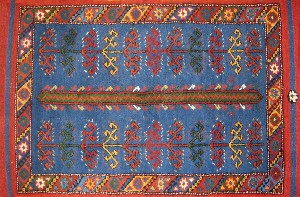The Plant Craft Cottage
Royal Botanic Gardens, Melbourne
by Pam Borchardt
Convenor, Natural Dye Group
The Plant Craft Cottage at the Royal Botanic Gardens, Melbourne, was built in 1850-51 and occupied first by Dr. Ferdinand von Mueller, the Government Botanist responsible for the establishment of the Gardens. Originally comprising three rooms, it was extended at the end of the nineteenth century and used for over one hundred years as a gardener's cottage. In the late 1970's it was renovated, and a small garden created around it.
Photograph Copyright by Pam Borchardt
The Cottage houses an extensive collection of books and periodicals covering plants and plant crafts. Included in the collection are many folders with samples of the work of the Natural Dye Group, which attract considerable interest.
The Natural Dye Group was established in 1981, along with the Baskerty Group, as part of the The Plant Craft Cottage Group. Later, the Fibre, Paper, Pressed Plant Card and Pot Pourri Groups were added. The Voluntary Guides of the Royal Botanic Gardens originally met in the Cottage, but now form an organisation on their own.
The Natural Dye Group was fortunate to have as founding Convenor Joan Bacon, an experienced long-time dyer who established a project to determine the dye potential of many Australian native plants, in particular eucalypts, using the Gerber Investigative method. Initially both alum and chrome were used as foundation mordants, but recently we decided not to use the chrome series because chrome is such a dangerous chemical.
Members of the Natural Dye Group have developed specific interests. Some are particularly interested in fungi dyeing and have travelled overseas to attend International Fungi and Fibre Symposia. Others have been attracted by indigo dyeing and have attended several of the International Shibori Symposia. A few of the Group have been interested in mud dyeing, following a visit to Australia by Judy Dominic from the USA, who gave a class in Bogolan Fini (a mud dyeing technique from Mali) at the Geelong Fibre Forum.
The main focus of the Group is eucalypt dyeing, and examples of the superb colours obtained from these were taken to Christchurch, New Zealand, for the Annual Conference of the New Zealand Spinning, Weaving and Woolcrafts Society in 1987. In 2006, a poster demonstrating the extensive range of colours obtained from eucalypts using a combination of mordants and also substantive dyeing for up to 9 hours was taken to the International Symposium on Natural Dyeing, Hyderabad, India, where it drew a great deal of attention.
The Group runs annual two-day workshops which are often over-booked. Recent topics have included working with eucalypt dyes, natural dyes on cotton for patch-workers and natural dyes for a knitted scarf.
The strength of the Group is demonstrated by the longtime and active support of many of its members who have participated tirelessly over the past 27 years.
 Turkey Red Journal
Turkey Red Journal
